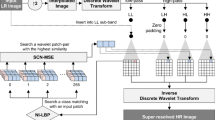Abstract
Currently, generating spatial image pyramid data mainly relies on down-sampling filtration, but so far, there is not any way to evaluate the effect of down-sampling. Herein, down-sampling and up-sampling were combined to form a pair of re-sampling filter, called RSFP, serving as an approximation of the current layer of pyramid data, can be used to evaluate the effect of the down-sampling filter. Based on RSFP, a pyramid-generating approach was built up in here, called it as TDFA. Its filtering depends on the texture direction of the pyramid image data. TDFA down-sampling PSNR was higher than the nearest neighbor interpolation, about 4.51–5.70 dB, while the latter was ever known the best down-sampling filter. The traditional JPEG compression method ignored the close correlations among the pyramid interlayer data, its compression process does not depend on the image texture features, which is not conducive to improving the compression ratio. The proposed RSFP and texture filtering method TDFA can effectively remove both correlations of pyramid image data, which respectively are the inter-layer correlations and its intra-layer texture correlations. Based on the re-sampling filter pair RSFP, combing these two means, an inter-layer compress method ICRS was created in this paper. Under the same reconstruction conditions, ICRS was found to increase the compression ratio 6.02 to 19.70 higher than the conventional AVS’s I-frame algorithm, and on the whole, its compression ratio is 3 times or more high than that of JPEG algorithm, and there still is considerable room for improvement.








Similar content being viewed by others
References
Acharya T, Ray AK (2005) Image processing: principles and applications. Wiley
Acharya T, Tsai P-S (2004) JPEG2000 standard for image compression: concepts, algorithms and VLSI architectures. Wiley-Interscience
Aggarwal HK, Majumdar A (2014) Single-sensor multi-spectral image demosaicing algorithm using learned interpolation weights. IEEE International Geoscience and Remote Sensing Symposium (IGARSS), 2011–2014
Agranov G, Gotsman C (1995) Algorithms for rendering realistic terrain image sequences and their parallel implementation. Vis Comput II(9):455–464
Baek M, Jeong J (2014) Demosaicing algorithm using high-order interpolation with sobel Operators. Proc. of the World Congress on Engineering and Computer Science
Bjorke JT, Nilsen S (2010) Wavelets applied to simplification of digital terrain models. Int J Geogr Inf Sci 17(7):601–621
Chang L, Tan YP (2004) Adaptive color filter array demosaicing with artifact suppression. Proc. of IEEE Int’l Symposium on Circuits and System. Canada Vancouver BC, vol 3, pp 937–940
Chen S, Bednarz T (2013) Galaxy + Hadoop: toward a collaborative and scalable image processing toolbox in cloud. The 3rd Int. Workshop on Cloud Computing and Scientific Applications (CCSA)
Dutton G (1996) Improving locational specificity of map data: a multi-resolution metadata-driven approach and notation. Int J Geogr Inf Syst 10(3):253–268
Fekete G (1990) Rendering, managing spherica1 data with sphere quadtrees. Proceedings of IEEE Visualizaton, pp 176–186
Goodchild MF, Yang SR (1992) A hierarchical spatial data structure for global geographic information systems. Geo-graphical Models Image Process 5, 1(1):31–44
Guilbert E, Gaffuri J, Jenny B (2014) Terrain generalisation. Abstracting Geographic Information in a Data Rich World, pp 227–258
Hirakawa K, Parks TW (2005) Adaptive homogeneity-directed demosaicing algorithm. IEEE Trans Image Process 14(3):360–369
Huang X, Cossairt O (2014) Dictionary learning based color demosaicing for plenoptic cameras. IEEE Conference on Computer Vision and Pattern Recognition Workshops (CVPRW), pp 455–460
ITU (1992) Information Technology–Digital Compression and Coding of Continuous-tone Still Images Requirements and Guidelines Recommendation T.: ITU
Klinger A, Dyer CR (1976) Experiments on picture representation using regular decomposition. Comp Graphics Image Process 5(1):68–105
Pabi O, Attua E (2009) Sustainable land use evaluation on steep landscapes and flood plains in the New Juaben District of Ghana: a GIS approach. Ghana J Geogr 1:115–134
Peleg T, Elad M (2014) A statistical prediction model based on sparse representations for single image super-resolution. IEEE Trans Image Process 23(6):2569–2582
Pennebaker WB, Mitchell JL (1993) JPEG: still image data compression standard. Chapman & Hall
Sahr K, White D, Kimerlin AJ (2003) Geodesic discrete global grid systems. Cartogr Geogr Inf Sci 30(2):121–131
Shen J, Ti C, Raghunathan A, Cheung S-cS, Patel R (2014) Automatic video self modeling for voice disorder. Multimedia Tools Appl 1–22
Sun S (2005) Deblocking filter for I-BL blocks in spatial scalable video coding-response to CE2 Part 2, Joint Video Team, Doc. JVT-P013, Jul
wenku.baidu.com. MPEG and H.26x, http://wenku.baidu.com/link?url=PiIpKJwYFNC8ZIXW-k6Ir79ItIK9BT2zEd6fzmJqleKr55IoHSwo_4xnzd07pn0ydV0YKiDKzXcCyO48iEGCAG1XcX6o6hExDGYr2jn-WOG
Yuan H, Kwong S, Liu J, Sun J (2013) A novel distortion model and Lagrangian multiplier for depth maps coding. IEEE Trans Circuits Syst Video Technol 24(3):443–451
Zimmer H, Lafarge F, Alliez P, Kobbelt L (2014) Zometool shape approximation. Geometric Modeling and Processing, pp 1–12
Acknowledgments
This work was financially supported by Natural Science Foundation of Shanxi (Grant No. 2013011017-3).
Author information
Authors and Affiliations
Corresponding author
Rights and permissions
About this article
Cite this article
Zhang, Y., Zhang, M., Wang, J. et al. ICRS: inter-layer compression method combined with generation of a spatial image pyramid. Multimed Tools Appl 75, 12077–12099 (2016). https://doi.org/10.1007/s11042-015-3193-1
Received:
Revised:
Accepted:
Published:
Issue Date:
DOI: https://doi.org/10.1007/s11042-015-3193-1




